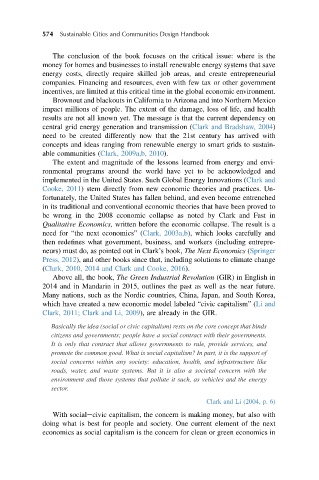Page 607 - Sustainable Cities and Communities Design Handbook
P. 607
574 Sustainable Cities and Communities Design Handbook
The conclusion of the book focuses on the critical issue: where is the
money for homes and businesses to install renewable energy systems that save
energy costs, directly require skilled job areas, and create entrepreneurial
companies. Financing and resources, even with few tax or other government
incentives, are limited at this critical time in the global economic environment.
Brownout and blackouts in California to Arizona and into Northern Mexico
impact millions of people. The extent of the damage, loss of life, and health
results are not all known yet. The message is that the current dependency on
central grid energy generation and transmission (Clark and Bradshaw, 2004)
need to be created differently now that the 21st century has arrived with
concepts and ideas ranging from renewable energy to smart grids to sustain-
able communities (Clark, 2009a,b, 2010).
The extent and magnitude of the lessons learned from energy and envi-
ronmental programs around the world have yet to be acknowledged and
implemented in the United States. Such Global Energy Innovations (Clark and
Cooke, 2011) stem directly from new economic theories and practices. Un-
fortunately, the United States has fallen behind, and even become entrenched
in its traditional and conventional economic theories that have been proved to
be wrong in the 2008 economic collapse as noted by Clark and Fast in
Qualitative Economics, written before the economic collapse. The result is a
need for “the next economics” (Clark, 2003a,b), which looks carefully and
then redefines what government, business, and workers (including entrepre-
neurs) must do, as pointed out in Clark’s book, The Next Economics (Springer
Press, 2012), and other books since that, including solutions to climate change
(Clark, 2010, 2014 and Clark and Cooke, 2016).
Above all, the book, The Green Industrial Revolution (GIR) in English in
2014 and in Mandarin in 2015, outlines the past as well as the near future.
Many nations, such as the Nordic countries, China, Japan, and South Korea,
which have created a new economic model labeled “civic capitalism” (Li and
Clark, 2011; Clark and Li, 2009), are already in the GIR.
Basically the idea (social or civic capitalism) rests on the core concept that binds
citizens and governments; people have a social contract with their governments.
It is only that contract that allows governments to rule, provide services, and
promote the common good. What is social capitalism? In part, it is the support of
social concerns within any society: education, health, and infrastructure like
roads, water, and waste systems. But it is also a societal concern with the
environment and those systems that pollute it such, as vehicles and the energy
sector.
Clark and Li (2004, p. 6)
With socialecivic capitalism, the concern is making money, but also with
doing what is best for people and society. One current element of the next
economics as social capitalism is the concern for clean or green economics in

